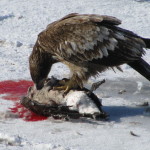Step out the back door this winter and scan the sky. You might spot our national bird soaring overhead.
A few decades ago eagle populations had been decimated by DDT poisoning and odds of spotting an eagle in Iowa were long. That’s changed as eagles began increasing in the 1990’s across the country. Although still not abundant, they are increasingly common in both rural and urban areas.
Eagles aren’t shy and don’t seem to mind being around people. They sometimes even nest inside city limits, usually in a large tree near water and cruise over neighborhoods in their search for food.
Winter is the most likely season to spot an eagle. During summer months some nest in warm states but more fly north to raise their young along remote lakes and streams in Minnesota, upper New England and Canada. When those northern lakes ice over in late fall eagles gradually move south until they find open water and plenty of fish. Dams create turbulence and factories sometimes discharge warm water that keep water open in otherwise frozen rivers. Eagles love these places and concentrate there, often even in the downtown of large cities.
Eagles enjoy eating fish but also feast on deer killed by cars and nearly any dead animal they can find. Don’t be surprised to see one on the edge of a highway having a venison breakfast.
Mature bald eagles of both genders have characteristic white tails and heads. When soaring at high elevation white feathers are nearly invisible against the sky and the bird looks headless and tailless.
Young bald eagles are nearly as big as their parents but their tails and heads are dark. White feathers don’t form until they are three or four years old. A high percentage of young birds are a sign of successful reproduction and a growing population.


